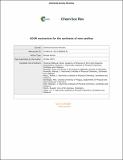Files in this item
The ADOR mechanism for the synthesis of new zeolites
Item metadata
| dc.contributor.author | Eliášová, P. | |
| dc.contributor.author | Opanasenko, M. | |
| dc.contributor.author | Wheatley, Paul Stewart | |
| dc.contributor.author | Shamzhy, M. | |
| dc.contributor.author | Mazur, M. | |
| dc.contributor.author | Nachtigall, P. | |
| dc.contributor.author | Roth, W.J. | |
| dc.contributor.author | Morris, Russell Edward | |
| dc.contributor.author | Čejka, J. | |
| dc.date.accessioned | 2016-05-05T23:32:04Z | |
| dc.date.available | 2016-05-05T23:32:04Z | |
| dc.date.issued | 2015-10-21 | |
| dc.identifier | 228942535 | |
| dc.identifier | f66f1aae-20ce-48d9-9014-0d3f75508aee | |
| dc.identifier | 84943391956 | |
| dc.identifier | 000362579900007 | |
| dc.identifier.citation | Eliášová , P , Opanasenko , M , Wheatley , P S , Shamzhy , M , Mazur , M , Nachtigall , P , Roth , W J , Morris , R E & Čejka , J 2015 , ' The ADOR mechanism for the synthesis of new zeolites ' , Chemical Society Reviews , vol. 44 , no. 20 , pp. 7177-7206 . https://doi.org/10.1039/c5cs00045a | en |
| dc.identifier.issn | 0306-0012 | |
| dc.identifier.other | ORCID: /0000-0001-7809-0315/work/61622079 | |
| dc.identifier.uri | https://hdl.handle.net/10023/8734 | |
| dc.description | This work was supported by the Czech Science Foundation Grant No. P106/12/G015 (Centre of Excellence) and Grant No. 14-30898P (MS only). W.J.R acknowledges partial financial support provided by the National Science Centre Poland with a grant approved under No. DEC-2011/03/B/ST5/01551. R.E.M. thanks the Royal Society for provision of an industry fellowship and the E.P.S.R.C. for funding (EP/K025112/1 and EP/L014475/1). | en |
| dc.description.abstract | A novel methodology, called ADOR (assembly-disassembly-organisation-reassembly), for the synthesis of zeolites is reviewed here in detail. The ADOR mechanism stems from the fact that certain chemical weakness against a stimulus may be present in a zeolite framework, which can then be utilized for the preparation of new solids through successive manipulation of the material. In this review, we discuss the critical factors of germanosilicate zeolites required for application of the ADOR protocol and describe the mechanism of hydrolysis, organisation and condensation to form new zeolites starting from zeolite UTL. Last but not least, we discuss the potential of this methodology to form other zeolites and the prospects for future investigations. | |
| dc.format.extent | 30 | |
| dc.format.extent | 3659877 | |
| dc.language.iso | eng | |
| dc.relation.ispartof | Chemical Society Reviews | en |
| dc.subject | QD Chemistry | en |
| dc.subject | NDAS | en |
| dc.subject.lcc | QD | en |
| dc.title | The ADOR mechanism for the synthesis of new zeolites | en |
| dc.type | Journal article | en |
| dc.contributor.sponsor | EPSRC | en |
| dc.contributor.sponsor | EPSRC | en |
| dc.contributor.institution | University of St Andrews. School of Chemistry | en |
| dc.contributor.institution | University of St Andrews. EaSTCHEM | en |
| dc.identifier.doi | 10.1039/c5cs00045a | |
| dc.description.status | Peer reviewed | en |
| dc.date.embargoedUntil | 2016-05-06 | |
| dc.identifier.grantnumber | EP/K025112/1 | en |
| dc.identifier.grantnumber | EP/L014475/1 | en |
This item appears in the following Collection(s)
Items in the St Andrews Research Repository are protected by copyright, with all rights reserved, unless otherwise indicated.

